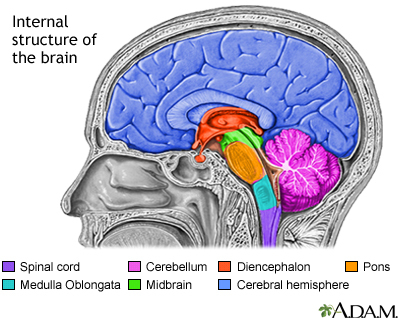Multiple system atrophy - cerebellar subtype
Definition
Multiple system atrophy - cerebellar subtype (MSA-C) is a rare disease that causes areas deep in the brain, just above the spinal cord, to shrink (atrophy). MSA-C used to be known as olivopontocerebellar atrophy (OPCA).
Alternative Names
MSA-C; Cerebellar multiple system atrophy; Olivopontocerebellar atrophy; OPCA; Olivopontocerebellar degeneration
Causes
MSA-C can be passed down through families (inherited form). It can also affect people without a known family history (sporadic form).
Researchers have identified certain genes that are involved in the inherited form of this condition.
The cause of MSA-C in people with the sporadic form is not known. The disease slowly gets worse (is progressive).
MSA-C is slightly more common in men than in women. The average age of onset is 54 years old.
Symptoms
Symptoms of MSA-C tend to start at a younger age in people with the inherited form. The main symptom is clumsiness (ataxia) that slowly gets worse. There may also be problems with balance, slurring of speech, and difficulty walking.
Other symptoms may include:
- Abnormal eye movements
- Abnormal movements
- Abnormal sweating
- Bowel or bladder problems
- Difficulty swallowing
- Cold hands and feet
- Lightheadedness when standing
- Headache while standing that is relieved by lying down
- Muscle stiffness or rigidity, spasms, tremor
- Nerve damage (neuropathy)
- Problems in speaking and sleeping due to spasms of the vocal cords
- Sexual function problems
Exams and Tests
A thorough medical and nervous system examination, as well as a symptom review and family history are needed to make the diagnosis.
There are genetic tests to look for the causes of some forms of the disorder. But, no specific test is available in many cases. An MRI of the brain may show changes in the size of affected brain structures, especially as the disease gets worse. But it is possible to have the disorder and have a normal MRI.
Other tests such as positron emission tomography (PET) may be done to rule out other conditions. These may include swallowing studies to see if a person can safely swallow food and liquid.
Treatment
There is no specific treatment or cure for MSA-C. The aim is to treat the symptoms and prevent complications. This may include:
- Tremor medicines, such as those for Parkinson disease
- Speech, occupational and physical therapy
- Ways to prevent choking
- Walking aids to help with balance and prevent falls
- Devices to treat sleep apnea (such as CPAP)
- Treatment for low blood pressure
Support Groups
More information and support for people with MSA-C and their families can be found at:
- Defeat MSA Alliance -- defeatmsa.org/patient-programs/
- The MSA Coalition -- www.multiplesystematrophy.org/msa-resources/
Outlook (Prognosis)
MSA-C slowly gets worse, and there is no cure. The outlook is generally poor. But, it may be years before someone is very disabled.
Possible Complications
Complications of MSA-C include:
- Choking
- Infection from inhaling food into the lungs (aspiration pneumonia)
- Injury from falls
- Nutrition problems due to difficulty swallowing
When to Contact a Medical Professional
Contact your health care provider if you have any symptoms of MSA-C. You will need to be seen by a neurologist. This is a doctor who treats nervous system problems.
Gallery

References
Jancovic J. Parkinson disease and other movement disorders. In: Jankovic J, Mazziotta JC, Pomeroy SL, Newman NJ, eds. Bradley and Daroff's Neurology in Clinical Practice. 8th ed. Philadelphia, PA: Elsevier; 2022:chap 96.
Jellinger KA. Neuropathology of movement disorders. In: Winn HR, ed. Youmans and Winn Neurological Surgery. 8th ed. Philadelphia, PA: Elsevier; 2023:chap 104.
Ma MJ. Biopsy pathology of neurodegenerative disorders in adults. In: Perry A, Brat DJ, eds. Practical Surgical Neuropathology: A Diagnostic Approach. 2nd ed. Philadelphia, PA: Elsevier, 2018:chap 27.
Walsh RR, Krismer F, Galpern WR, et al. Recommendations of the global multiple system atrophy research roadmap meeting. Neurology. 2018;90(2):74-82. PMID: 29237794 pubmed.ncbi.nlm.nih.gov/29237794/.
